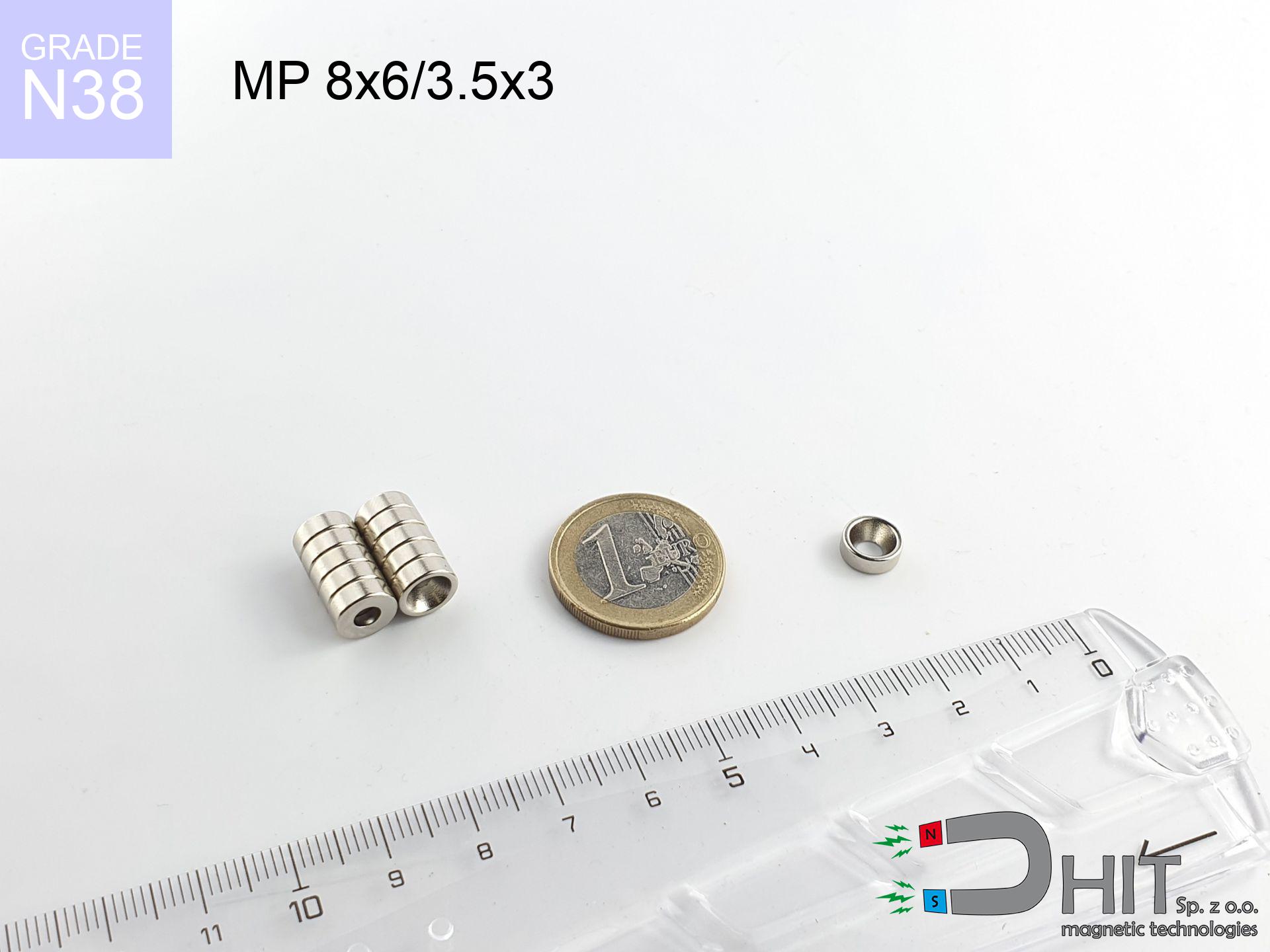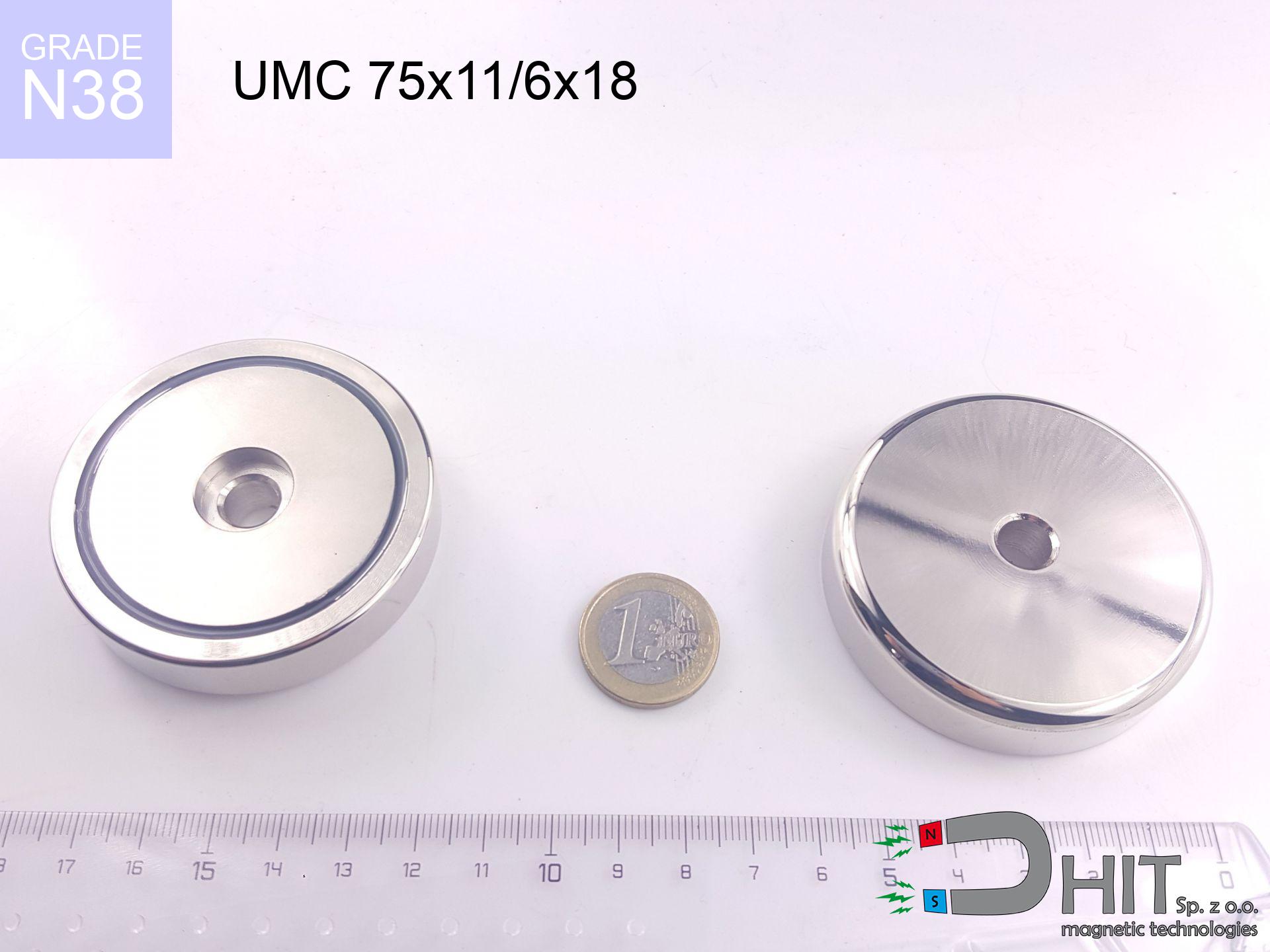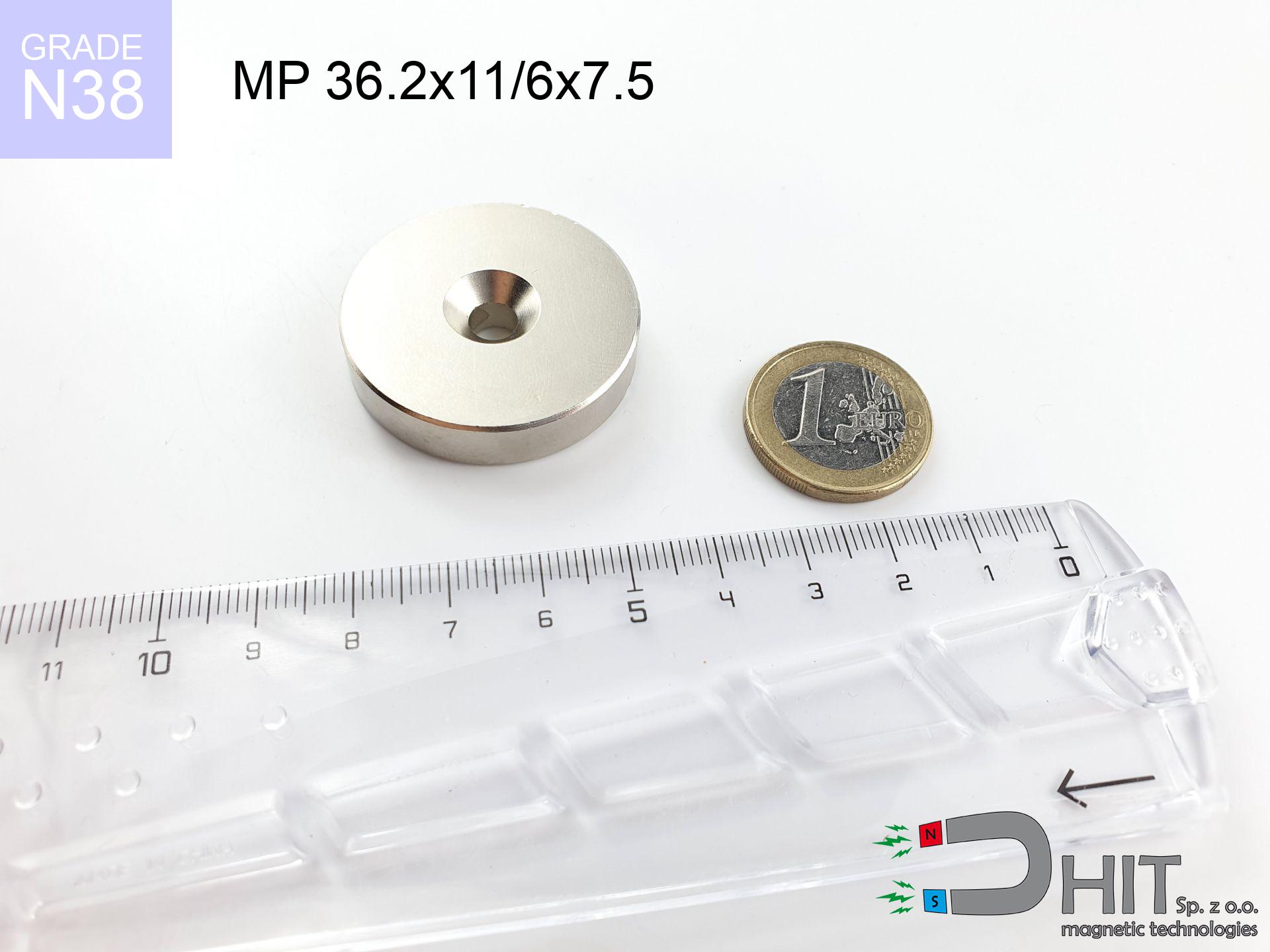MP 8x6/3.5x3 / N38 - ring magnet
ring magnet
Catalog no 030206
GTIN/EAN: 5906301812234
Diameter
8 mm [±0,1 mm]
internal diameter Ø
6/3.5 mm [±0,1 mm]
Height
3 mm [±0,1 mm]
Weight
0.91 g
Magnetization Direction
↑ axial
Load capacity
1.37 kg / 13.48 N
Magnetic Induction
371.53 mT / 3715 Gs
Coating
[NiCuNi] Nickel
0.701 ZŁ with VAT / pcs + price for transport
0.570 ZŁ net + 23% VAT / pcs
bulk discounts:
Need more?
Pick up the phone and ask
+48 888 99 98 98
alternatively contact us through
inquiry form
through our site.
Specifications and structure of neodymium magnets can be calculated with our
force calculator.
Same-day shipping for orders placed before 14:00.
Detailed specification - MP 8x6/3.5x3 / N38 - ring magnet
Specification / characteristics - MP 8x6/3.5x3 / N38 - ring magnet
| properties | values |
|---|---|
| Cat. no. | 030206 |
| GTIN/EAN | 5906301812234 |
| Production/Distribution | Dhit sp. z o.o. |
| Country of origin | Poland / China / Germany |
| Customs code | 85059029 |
| Diameter | 8 mm [±0,1 mm] |
| internal diameter Ø | 6/3.5 mm [±0,1 mm] |
| Height | 3 mm [±0,1 mm] |
| Weight | 0.91 g |
| Magnetization Direction | ↑ axial |
| Load capacity ~ ? | 1.37 kg / 13.48 N |
| Magnetic Induction ~ ? | 371.53 mT / 3715 Gs |
| Coating | [NiCuNi] Nickel |
| Manufacturing Tolerance | ±0.1 mm |
Magnetic properties of material N38
| properties | values | units |
|---|---|---|
| remenance Br [min. - max.] ? | 12.2-12.6 | kGs |
| remenance Br [min. - max.] ? | 1220-1260 | mT |
| coercivity bHc ? | 10.8-11.5 | kOe |
| coercivity bHc ? | 860-915 | kA/m |
| actual internal force iHc | ≥ 12 | kOe |
| actual internal force iHc | ≥ 955 | kA/m |
| energy density [min. - max.] ? | 36-38 | BH max MGOe |
| energy density [min. - max.] ? | 287-303 | BH max KJ/m |
| max. temperature ? | ≤ 80 | °C |
Physical properties of sintered neodymium magnets Nd2Fe14B at 20°C
| properties | values | units |
|---|---|---|
| Vickers hardness | ≥550 | Hv |
| Density | ≥7.4 | g/cm3 |
| Curie Temperature TC | 312 - 380 | °C |
| Curie Temperature TF | 593 - 716 | °F |
| Specific resistance | 150 | μΩ⋅cm |
| Bending strength | 250 | MPa |
| Compressive strength | 1000~1100 | MPa |
| Thermal expansion parallel (∥) to orientation (M) | (3-4) x 10-6 | °C-1 |
| Thermal expansion perpendicular (⊥) to orientation (M) | -(1-3) x 10-6 | °C-1 |
| Young's modulus | 1.7 x 104 | kg/mm² |
Physical simulation of the magnet - technical parameters
These information represent the outcome of a engineering calculation. Results are based on algorithms for the class Nd2Fe14B. Actual performance might slightly deviate from the simulation results. Use these data as a preliminary roadmap during assembly planning.
Table 1: Static pull force (pull vs gap) - characteristics
MP 8x6/3.5x3 / N38
| Distance (mm) | Induction (Gauss) / mT | Pull Force (kg) | Risk Status |
|---|---|---|---|
| 0 mm |
3327 Gs
332.7 mT
|
1.37 kg / 1370.0 g
13.4 N
|
low risk |
| 1 mm |
2612 Gs
261.2 mT
|
0.84 kg / 844.4 g
8.3 N
|
low risk |
| 2 mm |
1884 Gs
188.4 mT
|
0.44 kg / 439.3 g
4.3 N
|
low risk |
| 3 mm |
1310 Gs
131.0 mT
|
0.21 kg / 212.4 g
2.1 N
|
low risk |
| 5 mm |
637 Gs
63.7 mT
|
0.05 kg / 50.3 g
0.5 N
|
low risk |
| 10 mm |
151 Gs
15.1 mT
|
0.00 kg / 2.8 g
0.0 N
|
low risk |
| 15 mm |
54 Gs
5.4 mT
|
0.00 kg / 0.4 g
0.0 N
|
low risk |
| 20 mm |
25 Gs
2.5 mT
|
0.00 kg / 0.1 g
0.0 N
|
low risk |
| 30 mm |
8 Gs
0.8 mT
|
0.00 kg / 0.0 g
0.0 N
|
low risk |
| 50 mm |
2 Gs
0.2 mT
|
0.00 kg / 0.0 g
0.0 N
|
low risk |
Table 2: Vertical hold (vertical surface)
MP 8x6/3.5x3 / N38
| Distance (mm) | Friction coefficient | Pull Force (kg) |
|---|---|---|
| 0 mm | Stal (~0.2) |
0.27 kg / 274.0 g
2.7 N
|
| 1 mm | Stal (~0.2) |
0.17 kg / 168.0 g
1.6 N
|
| 2 mm | Stal (~0.2) |
0.09 kg / 88.0 g
0.9 N
|
| 3 mm | Stal (~0.2) |
0.04 kg / 42.0 g
0.4 N
|
| 5 mm | Stal (~0.2) |
0.01 kg / 10.0 g
0.1 N
|
| 10 mm | Stal (~0.2) |
0.00 kg / 0.0 g
0.0 N
|
| 15 mm | Stal (~0.2) |
0.00 kg / 0.0 g
0.0 N
|
| 20 mm | Stal (~0.2) |
0.00 kg / 0.0 g
0.0 N
|
| 30 mm | Stal (~0.2) |
0.00 kg / 0.0 g
0.0 N
|
| 50 mm | Stal (~0.2) |
0.00 kg / 0.0 g
0.0 N
|
Table 3: Wall mounting (shearing) - behavior on slippery surfaces
MP 8x6/3.5x3 / N38
| Surface type | Friction coefficient / % Mocy | Max load (kg) |
|---|---|---|
| Raw steel |
µ = 0.3
30% Nominalnej Siły
|
0.41 kg / 411.0 g
4.0 N
|
| Painted steel (standard) |
µ = 0.2
20% Nominalnej Siły
|
0.27 kg / 274.0 g
2.7 N
|
| Oily/slippery steel |
µ = 0.1
10% Nominalnej Siły
|
0.14 kg / 137.0 g
1.3 N
|
| Magnet with anti-slip rubber |
µ = 0.5
50% Nominalnej Siły
|
0.69 kg / 685.0 g
6.7 N
|
Table 4: Steel thickness (saturation) - power losses
MP 8x6/3.5x3 / N38
| Steel thickness (mm) | % power | Real pull force (kg) |
|---|---|---|
| 0.5 mm |
|
0.14 kg / 137.0 g
1.3 N
|
| 1 mm |
|
0.34 kg / 342.5 g
3.4 N
|
| 2 mm |
|
0.69 kg / 685.0 g
6.7 N
|
| 5 mm |
|
1.37 kg / 1370.0 g
13.4 N
|
| 10 mm |
|
1.37 kg / 1370.0 g
13.4 N
|
Table 5: Working in heat (stability) - power drop
MP 8x6/3.5x3 / N38
| Ambient temp. (°C) | Power loss | Remaining pull | Status |
|---|---|---|---|
| 20 °C | 0.0% |
1.37 kg / 1370.0 g
13.4 N
|
OK |
| 40 °C | -2.2% |
1.34 kg / 1339.9 g
13.1 N
|
OK |
| 60 °C | -4.4% |
1.31 kg / 1309.7 g
12.8 N
|
|
| 80 °C | -6.6% |
1.28 kg / 1279.6 g
12.6 N
|
|
| 100 °C | -28.8% |
0.98 kg / 975.4 g
9.6 N
|
Table 6: Two magnets (attraction) - field collision
MP 8x6/3.5x3 / N38
| Gap (mm) | Attraction (kg) (N-S) | Repulsion (kg) (N-N) |
|---|---|---|
| 0 mm |
2.36 kg / 2357 g
23.1 N
4 867 Gs
|
N/A |
| 1 mm |
1.90 kg / 1905 g
18.7 N
5 981 Gs
|
1.71 kg / 1714 g
16.8 N
~0 Gs
|
| 2 mm |
1.45 kg / 1453 g
14.3 N
5 223 Gs
|
1.31 kg / 1308 g
12.8 N
~0 Gs
|
| 3 mm |
1.06 kg / 1063 g
10.4 N
4 468 Gs
|
0.96 kg / 957 g
9.4 N
~0 Gs
|
| 5 mm |
0.53 kg / 528 g
5.2 N
3 148 Gs
|
0.47 kg / 475 g
4.7 N
~0 Gs
|
| 10 mm |
0.09 kg / 86 g
0.8 N
1 274 Gs
|
0.08 kg / 78 g
0.8 N
~0 Gs
|
| 20 mm |
0.00 kg / 5 g
0.0 N
301 Gs
|
0.00 kg / 0 g
0.0 N
~0 Gs
|
| 50 mm |
0.00 kg / 0 g
0.0 N
27 Gs
|
0.00 kg / 0 g
0.0 N
~0 Gs
|
Table 7: Protective zones (implants) - precautionary measures
MP 8x6/3.5x3 / N38
| Object / Device | Limit (Gauss) / mT | Safe distance |
|---|---|---|
| Pacemaker | 5 Gs (0.5 mT) | 4.0 cm |
| Hearing aid | 10 Gs (1.0 mT) | 3.0 cm |
| Mechanical watch | 20 Gs (2.0 mT) | 2.5 cm |
| Mobile device | 40 Gs (4.0 mT) | 2.0 cm |
| Remote | 50 Gs (5.0 mT) | 2.0 cm |
| Payment card | 400 Gs (40.0 mT) | 1.0 cm |
| HDD hard drive | 600 Gs (60.0 mT) | 1.0 cm |
Table 8: Impact energy (kinetic energy) - warning
MP 8x6/3.5x3 / N38
| Start from (mm) | Speed (km/h) | Energy (J) | Predicted outcome |
|---|---|---|---|
| 10 mm |
39.18 km/h
(10.88 m/s)
|
0.05 J | |
| 30 mm |
67.78 km/h
(18.83 m/s)
|
0.16 J | |
| 50 mm |
87.50 km/h
(24.31 m/s)
|
0.27 J | |
| 100 mm |
123.74 km/h
(34.37 m/s)
|
0.54 J |
Table 9: Coating parameters (durability)
MP 8x6/3.5x3 / N38
| Technical parameter | Value / Description |
|---|---|
| Coating type | [NiCuNi] Nickel |
| Layer structure | Nickel - Copper - Nickel |
| Layer thickness | 10-20 µm |
| Salt spray test (SST) ? | 24 h |
| Recommended environment | Indoors only (dry) |
Table 10: Electrical data (Flux)
MP 8x6/3.5x3 / N38
| Parameter | Value | SI Unit / Description |
|---|---|---|
| Magnetic Flux | 1 299 Mx | 13.0 µWb |
| Pc Coefficient | 0.46 | Low (Flat) |
Table 11: Submerged application
MP 8x6/3.5x3 / N38
| Environment | Effective steel pull | Effect |
|---|---|---|
| Air (land) | 1.37 kg | Standard |
| Water (riverbed) |
1.57 kg
(+0.20 kg Buoyancy gain)
|
+14.5% |
1. Shear force
*Caution: On a vertical wall, the magnet retains only a fraction of its nominal pull.
2. Plate thickness effect
*Thin steel (e.g. computer case) significantly reduces the holding force.
3. Thermal stability
*For N38 grade, the max working temp is 80°C.
4. Demagnetization curve and operating point (B-H)
chart generated for the permeance coefficient Pc (Permeance Coefficient) = 0.46
This simulation demonstrates the magnetic stability of the selected magnet under specific geometric conditions. The solid red line represents the demagnetization curve (material potential), while the dashed blue line is the load line based on the magnet's geometry. The Pc (Permeance Coefficient), also known as the load line slope, is a dimensionless value that describes the relationship between the magnet's shape and its magnetic stability. The intersection of these two lines (the black dot) is the operating point — it determines the actual magnetic flux density generated by the magnet in this specific configuration. A higher Pc value means the magnet is more 'slender' (tall relative to its area), resulting in a higher operating point and better resistance to irreversible demagnetization caused by external fields or temperature. A value of 0.42 is relatively low (typical for flat magnets), meaning the operating point is closer to the 'knee' of the curve — caution is advised when operating at temperatures near the maximum limit to avoid strength loss.
Chemical composition
| iron (Fe) | 64% – 68% |
| neodymium (Nd) | 29% – 32% |
| boron (B) | 1.1% – 1.2% |
| dysprosium (Dy) | 0.5% – 2.0% |
| coating (Ni-Cu-Ni) | < 0.05% |
Sustainability
| recyclability (EoL) | 100% |
| recycled raw materials | ~10% (pre-cons) |
| carbon footprint | low / zredukowany |
| waste code (EWC) | 16 02 16 |
View also offers
Strengths and weaknesses of neodymium magnets.
Pros
- They virtually do not lose power, because even after ten years the decline in efficiency is only ~1% (in laboratory conditions),
- They feature excellent resistance to magnetic field loss as a result of opposing magnetic fields,
- A magnet with a metallic nickel surface looks better,
- They feature high magnetic induction at the operating surface, which increases their power,
- Due to their durability and thermal resistance, neodymium magnets can operate (depending on the form) even at high temperatures reaching 230°C or more...
- Thanks to versatility in forming and the ability to adapt to specific needs,
- Huge importance in modern technologies – they are used in data components, electric motors, diagnostic systems, also industrial machines.
- Thanks to their power density, small magnets offer high operating force, in miniature format,
Weaknesses
- To avoid cracks under impact, we recommend using special steel holders. Such a solution secures the magnet and simultaneously improves its durability.
- When exposed to high temperature, neodymium magnets suffer a drop in power. Often, when the temperature exceeds 80°C, their power decreases (depending on the size and shape of the magnet). For those who need magnets for extreme conditions, we offer [AH] versions withstanding up to 230°C
- Due to the susceptibility of magnets to corrosion in a humid environment, we recommend using waterproof magnets made of rubber, plastic or other material stable to moisture, in case of application outdoors
- Due to limitations in producing nuts and complex shapes in magnets, we propose using a housing - magnetic mechanism.
- Possible danger related to microscopic parts of magnets pose a threat, if swallowed, which is particularly important in the aspect of protecting the youngest. Additionally, small components of these devices are able to be problematic in diagnostics medical in case of swallowing.
- With budget limitations the cost of neodymium magnets can be a barrier,
Pull force analysis
Maximum lifting force for a neodymium magnet – what it depends on?
- with the application of a sheet made of special test steel, ensuring full magnetic saturation
- possessing a massiveness of min. 10 mm to avoid saturation
- with a surface perfectly flat
- without any clearance between the magnet and steel
- under perpendicular force direction (90-degree angle)
- at room temperature
Impact of factors on magnetic holding capacity in practice
- Space between magnet and steel – even a fraction of a millimeter of distance (caused e.g. by veneer or unevenness) diminishes the magnet efficiency, often by half at just 0.5 mm.
- Force direction – note that the magnet holds strongest perpendicularly. Under shear forces, the capacity drops significantly, often to levels of 20-30% of the nominal value.
- Metal thickness – the thinner the sheet, the weaker the hold. Part of the magnetic field penetrates through instead of converting into lifting capacity.
- Metal type – different alloys attracts identically. High carbon content weaken the interaction with the magnet.
- Surface condition – smooth surfaces guarantee perfect abutment, which improves force. Uneven metal weaken the grip.
- Thermal environment – temperature increase causes a temporary drop of induction. Check the maximum operating temperature for a given model.
Holding force was measured on the plate surface of 20 mm thickness, when a perpendicular force was applied, whereas under shearing force the load capacity is reduced by as much as 5 times. Moreover, even a slight gap between the magnet and the plate decreases the load capacity.
H&S for magnets
Warning for allergy sufferers
Medical facts indicate that the nickel plating (standard magnet coating) is a common allergen. If your skin reacts to metals, prevent touching magnets with bare hands or select coated magnets.
Implant safety
People with a pacemaker should maintain an absolute distance from magnets. The magnetism can disrupt the operation of the life-saving device.
Protect data
Equipment safety: Strong magnets can damage payment cards and sensitive devices (heart implants, medical aids, timepieces).
Dust explosion hazard
Combustion risk: Rare earth powder is explosive. Avoid machining magnets without safety gear as this risks ignition.
Bone fractures
Large magnets can crush fingers instantly. Never place your hand between two strong magnets.
Do not overheat magnets
Watch the temperature. Exposing the magnet above 80 degrees Celsius will ruin its properties and pulling force.
Caution required
Before use, read the rules. Sudden snapping can destroy the magnet or injure your hand. Be predictive.
No play value
Only for adults. Tiny parts can be swallowed, causing severe trauma. Store away from kids and pets.
Eye protection
NdFeB magnets are sintered ceramics, which means they are very brittle. Impact of two magnets will cause them cracking into small pieces.
Phone sensors
Be aware: rare earth magnets produce a field that interferes with sensitive sensors. Keep a separation from your phone, device, and GPS.









